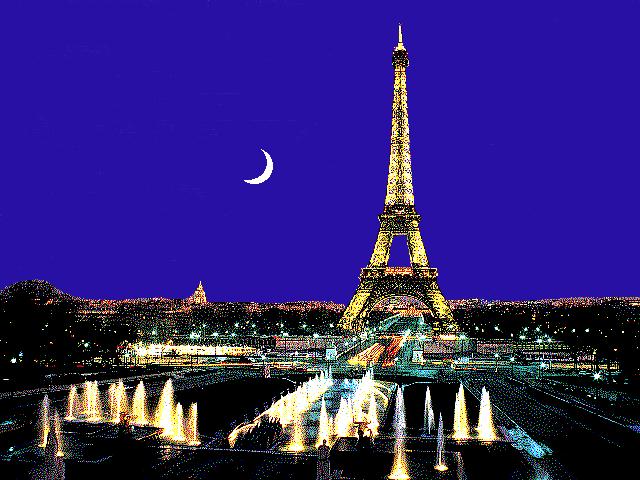Another Charles Garnier building
Labels :
Charles Garnier,
Paris 6
 When walking from the Cour du Commerce Saint André and Cour Rohan (see my two preceding posts), along Boulevard Saint Germain in the direction of the church Saint Germain des Prés (or the cafés Les Deux Magots and Flore etc…) you can find a building created by Charles Garnier,
When walking from the Cour du Commerce Saint André and Cour Rohan (see my two preceding posts), along Boulevard Saint Germain in the direction of the church Saint Germain des Prés (or the cafés Les Deux Magots and Flore etc…) you can find a building created by Charles Garnier, … who of course is particularly known as the architect of Opéra Garnier (see my post August 2, 2007). This is a very much more modest building.
… who of course is particularly known as the architect of Opéra Garnier (see my post August 2, 2007). This is a very much more modest building.Actually, Charles had some difficulties to find new jobs after the Paris opera house, much criticized those days, much praised later, and he had to wait two years after finishing the opera to get this job in 1877.
 However, he then, later, also created the casino (Wikipedia photo), opera and Hôtel de Paris in Monte Carlo, the casino and the spa hotel in Vittel, a theatre in Paris (Marigny) and several other buildings.
However, he then, later, also created the casino (Wikipedia photo), opera and Hôtel de Paris in Monte Carlo, the casino and the spa hotel in Vittel, a theatre in Paris (Marigny) and several other buildings. He also created the tomb of Jacques Offenbach in 1880 (see my post April 24, 2007).
He also created the tomb of Jacques Offenbach in 1880 (see my post April 24, 2007).This building on Boulevard Saint Germain (no. 117), completed in 1879 is not one of the most well known among his creations, but is certainly worth having a look at. It was built for the “Le Cercle de la Librairie”, where all syndicates and professional associations representing the publishing and editing industry met until 1979. Today, after some interior modifications, the building houses L’Ecole Nationale du Patrimoine (the National School of Patrimony) which should give a good guarantee that the building will be kept in good shape.
It’s not open for visits, but I managed to get in - thanks to a tolerant door man - and to take a few pictures also of the interior stairs.
 I put the original pictures on my photo blog.
I put the original pictures on my photo blog.... and it's again time to wish you a nice weekend!












 From the interior you can note a beautiful pulpit, the Chapel of the Madonna (statue by Pigalle) and some wall paintings by Delacroix (too dark to be correctly photographed).
From the interior you can note a beautiful pulpit, the Chapel of the Madonna (statue by Pigalle) and some wall paintings by Delacroix (too dark to be correctly photographed). 
 The church is known for its organ, which is supposed to be one of the best in the world, created by Arisitide Cavaillé-Coll in 1862, but still with a lot of material from its original construction in 1781. Cavaillé-Coll is considered as one of the world’s best organ builders ever. The church has also always employed top class organists (and composers). The organ is frequently used for concerts and recordings.
The church is known for its organ, which is supposed to be one of the best in the world, created by Arisitide Cavaillé-Coll in 1862, but still with a lot of material from its original construction in 1781. Cavaillé-Coll is considered as one of the world’s best organ builders ever. The church has also always employed top class organists (and composers). The organ is frequently used for concerts and recordings.


















 I would however especially like to draw the attention to some covered pedestrian passages. There are some 25 similar pedestrian passages in Paris. I have already posted about
I would however especially like to draw the attention to some covered pedestrian passages. There are some 25 similar pedestrian passages in Paris. I have already posted about  The second one is called Passage du Grand Cerf. It dates from about 1830. Previously this was the place for a restaurant with the same name (Big Stag) which until the Revolution was the departure and arrival point of mail-coaches of the “Messageries Royales”, destroyed in 1825. This is the highest of all Parisian passages (some 12 metres = 40 ft) and you can find some surprising shop signs. It has been renovated the last decades and you can today find some nice shops, although it’s not the most visited one of the Paris pedestrian passages. ... but it’s a beauty for the eyes!
The second one is called Passage du Grand Cerf. It dates from about 1830. Previously this was the place for a restaurant with the same name (Big Stag) which until the Revolution was the departure and arrival point of mail-coaches of the “Messageries Royales”, destroyed in 1825. This is the highest of all Parisian passages (some 12 metres = 40 ft) and you can find some surprising shop signs. It has been renovated the last decades and you can today find some nice shops, although it’s not the most visited one of the Paris pedestrian passages. ... but it’s a beauty for the eyes!

 There is a very nice looking restaurant (which I have not tried), “L’Escargot” (The Snail) which dates from 1832. Their specialty is as the name indicates snails in different forms. Many celebrities have been dining here, including Sarah Bernhardt and part of the interior decoration comes from her home.
There is a very nice looking restaurant (which I have not tried), “L’Escargot” (The Snail) which dates from 1832. Their specialty is as the name indicates snails in different forms. Many celebrities have been dining here, including Sarah Bernhardt and part of the interior decoration comes from her home.  At last I would like to mention “Au Rocher de Cancale” (The Rock of Cancale), knowing that Cancale is in Brittany; in former days this used to be the major street for oysters and other sea food. You can see the façade on the top photo. It may be interesting to know that during the 19th century the average yearly consumption of oysters among the adult population in Paris is estimated to something like 25 dozens! Oysters normally did not even appear on the menu, they were just some kind of cocktail snacks. Consider then also that oysters could then not be transported during the warmer months (the months without “r”)!
At last I would like to mention “Au Rocher de Cancale” (The Rock of Cancale), knowing that Cancale is in Brittany; in former days this used to be the major street for oysters and other sea food. You can see the façade on the top photo. It may be interesting to know that during the 19th century the average yearly consumption of oysters among the adult population in Paris is estimated to something like 25 dozens! Oysters normally did not even appear on the menu, they were just some kind of cocktail snacks. Consider then also that oysters could then not be transported during the warmer months (the months without “r”)!
 Rue Montorgueil is one of the older Paris streets (13th century), has had different names before it got its present name during the 17th century; the name in English would actually be Mount Pride Street or something similar - it was the way to a rather lousy area which was called Mount Pride (Mont Orgeuilleux) by mockery.
Rue Montorgueil is one of the older Paris streets (13th century), has had different names before it got its present name during the 17th century; the name in English would actually be Mount Pride Street or something similar - it was the way to a rather lousy area which was called Mount Pride (Mont Orgeuilleux) by mockery.


 Please note that the street is busy during the day, but very (too?) calm late evening.
Please note that the street is busy during the day, but very (too?) calm late evening.








